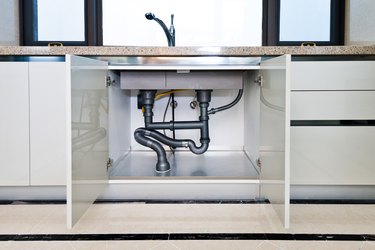
The P-trap is a nifty little invention without which plumbing drains would be unsanitary, allowing odors, vermin and flammable gases to plague household kitchens and bathrooms. The short length of U-shaped pipe under every sink and (although you can't see it) bathtub and shower holds a pool of water, and this water is all it takes to effectively seal sewer gases into the pipes.
P-traps need occasional cleaning, so they're designed to be easy to remove. The compression nuts holding a sink trap to the tailpiece and waste arm are designed to be hand tightened, and when you do it properly, the trap is watertight. When a P-trap leak occurs, it's usually because the nuts aren't tight enough, the pipes are misaligned or a P-trap washer isn't seated correctly.
Video of the Day
Video of the Day
How to Diagnose a P-Trap Leak
A P-trap leak isn't like a leak from a pressurized water pipe, and because it only happens when water is draining from the sink, you might not know it's there until water begins collecting on the bottom of the cabinet. If the bottom of the cabinet is wet and you don't see water spraying from any of the water connections, check the P-trap by filling the sink, opening the stopper and watching the trap as the water drains.
When water leaks from one of the connections, it tends to flow along the pipe and drip from the lowest point. To determine which connection is leaking, wrap your fingers around the pipe just under each connection and watch for water pooling around your fingers. Once you find which connection is leaking, you'll have a better idea of what to do next.
How to Tighten a Loose P-Trap Connection
When a P-trap compression collar leaks, it may just need tightening. You're supposed to be able to do this by hand, but if you can't muster enough strength to stop the leak, which is often the case if the P-trap is made of chrome steel, you may want to use a pair of locking pliers. Don't overdo it, though, or you could end up stripping or cracking the nut.
If you have to resort to pliers, it's better to use two pairs, not just one. The second pair is for holding the pipe steady while you turn the nut. If you don't do this, the torque you apply on the nut can pull the trap connection out of alignment, and the trap will continue to leak.
Stop a Leak by Disassembling the Trap
If you can't stop the leak by tightening the compression collar, try taking the connection apart and putting it back together. When you take it apart, you'll probably see why it's leaking. It could be because the pipe going into the collar isn't straight because the P-trap washer isn't fully seated or because the pipe going into the collar is too short.
The P-trap washer is a plastic ring that slides along the male part of the connection and has a taper that fits snugly inside the female part of the connections. If this goes into the pipe at an angle, or it has been installed upside down, simply redo it the right way and the leak will stop. If the washer is cracked or nicked, replace it with a new one.
Sometimes the sink drain doesn't line up perfectly with the waste outlet in the arm, and because of the offset, the P-trap connections aren't straight. If you can't stop leaks by tightening these off-kilter connections, you may have to disassemble the entire trap and rebuild it with extra lengths of pipe to make the connections straight.
Read more: How to Replace a Sink Drain P-Trap